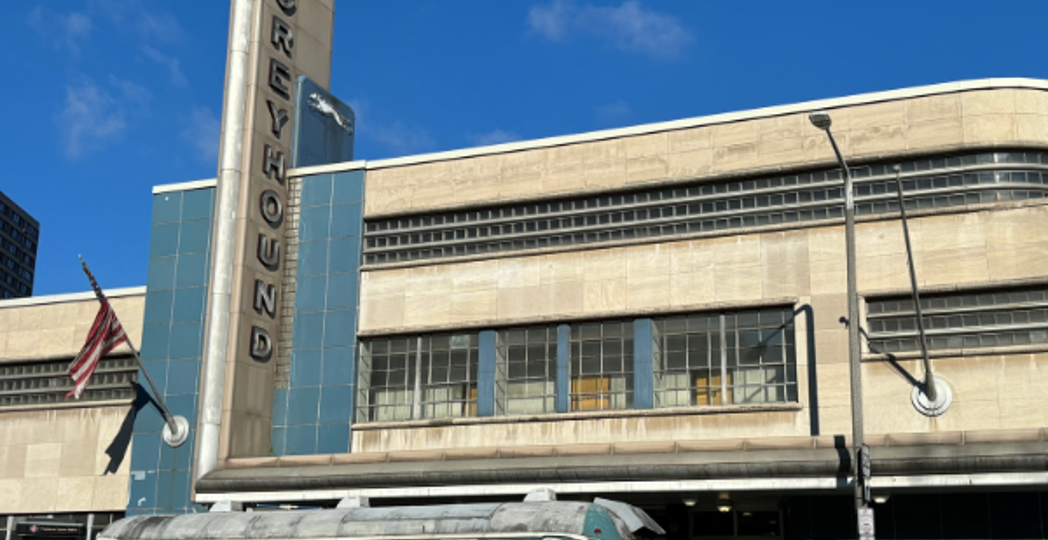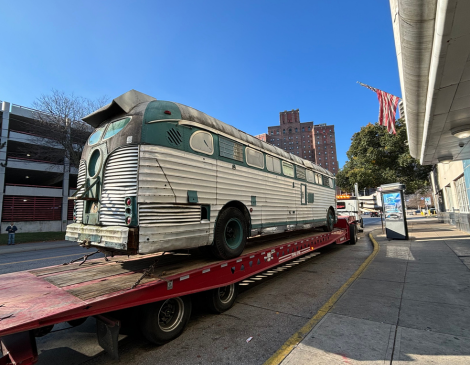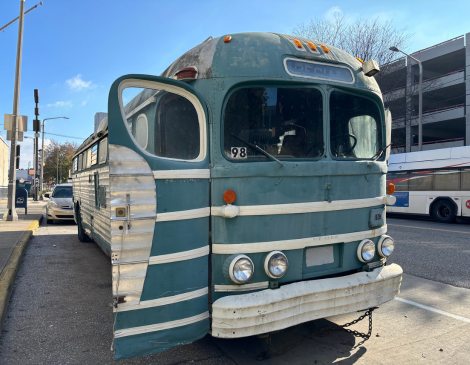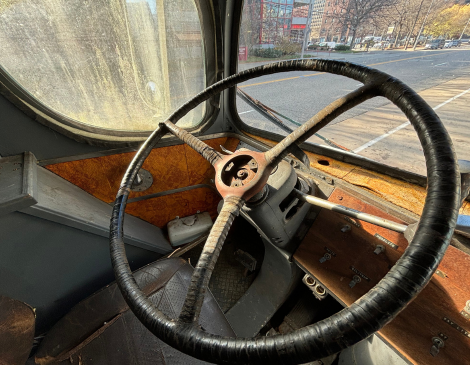Playhouse Square's Plans for Greyhound Station Take Shape With One Historic Bus
by Sharon Holbrook | Nov. 16, 2024 | 10:00 AM

Sharon Holbrook
Usually, a bus arriving at the downtown Greyhound station on Chester Avenue is an unremarkable event. But last Friday morning, a bus rolled up and created a bit of a scene. People on foot and in cars stopped to watch, pulled out their cameras, and asked questions. The attraction? A 1947 Greyhound bus, worn down by the years but still magnificent in sleek blue and silver, had arrived on a flatbed truck.
As Greyhound plans to exit the station (it will continue to operate bus service there through June 2025) the arrival of the vintage bus is the first tangible sign of the historic station’s next phase. Earlier in 2024, Playhouse Square Foundation purchased the building as part of its plan to expand its footprint beyond a theater district to create a broader downtown destination, says Craig Hassall, CEO of Playhouse Square Foundation.
RELATED: Playhouse Square Purchases Greyhound Bus Station
A hefty dose of right-place-right-time energy brought the bus to Chester Avenue. Its owner is Robert Louis Brandon Edwards, a Ph.D. student in historic preservation at Columbia University who recently moved to Cleveland.

Edwards’ expertise is in Black migration by Greyhound bus, and since 2023 he had wanted to purchase an authentic period bus that he could restore and use to share this part of the story of the Great Migration. Buses and the Black experience, he says, are about more than segregation and bus boycotts. “What this project seeks to do is fill those gaps in history, where we don’t just associate the bus with Rosa Parks or the Freedom Rides, but we associate the bus with agency, freedom, opportunity, and accessibility,” said Edwards. From these journeys “a new form of Blackness, a melting pot of southern and northern, an expansion of the Black diaspora” emerged, he said.
RELATED: Looking Back on Cleveland Greyhound Station's Groundbreaking Debut
After a hit-or-miss search of listings across the country, Edwards found the 1947 Raymond Loewy-designed bus — possibly the very model of bus that carried his mother, aunt and grandmother on their migration from rural Virginia to Harlem. Its interior was dramatically altered by a private owner to convert it to an RV, probably in the 1970s, but key features remain. At the rear of the bus, in its original condition, is the back bench where migrating Black passengers would have had to sit in that Jim Crow era.
When Edwards heard about Playhouse Square’s purchase of the Cleveland station — and Playhouse Square heard about Edwards’ bus and his plans for it — both were thrilled about the possible synergies.

Playhouse Square is not planning a traditional theater with timed shows for the space, said Hassall. Instead, it’s exploring a variety of dining, entertainment and event options, along with a careful restoration that bolsters the architectural integrity and social history of the station. The organization had never intended to erase the Greyhound history from the space, even before Edwards and his bus came along. It had already been brainstorming with Karamu House, an affiliate company of Playhouse Square, about eventually creating an immersive theater piece relating to Greyhound travel.
RELATED: “Brel”: the Musical Revue That Saved Playhouse Square
For his part, Edwards was already excited about the importance of the Cleveland station both architecturally and as part of the Great Migration before he met the team at Playhouse Square. (The Streamline Moderne style bus station has been on the National Register of Historic Places since 1999.) Edwards was looking to not only find a home base for his bus restoration project, but also ultimately open it to the public as a museum-type space.
“There is a void in museum and art interpretation of the Great Migration through the use of Greyhound,” said Edwards. “Everyone at Playhouse Square has been great. Their response to my work and my vision has been nothing but support and excitement.”

For now, there’s still a lot to get done. Edwards has a long bus restoration project ahead of him. There’s even talk of getting a second Greyhound bus so that one could be based at the station, and one could act as a traveling exhibit. Playhouse Square is currently undertaking a comprehensive study of its whole campus with Streetsense consultants to envision and plan for the best use of its properties, and that study will be complete in February 2025. Fundraising efforts will be undertaken by Playhouse Square in the next few years to support the work. Physical restoration of the neglected station — and adaptation for its new uses — will need to be undertaken.
All in all, Hassall estimates that it may be three years before the station is open for business in its next era.
On Friday morning, there was little sign of what’s to come inside the station, where loaded-down passengers waited, and the mood was subdued. Playhouse Square doesn’t want its renovations to erase the experience of everyday Clevelanders like these travelers.
“I don't want it to be this sort of rarefied, posh restaurant,” said Hassall. “I want it to be absolutely accessible to everyone in Cleveland.”
RELATED: Craig Hassall, Most Interesting People 2023
For more updates about Cleveland, sign up for our Cleveland Magazine Daily newsletter, delivered to your inbox six times a week.
Cleveland Magazine is also available in print, publishing 12 times a year with immersive features, helpful guides and beautiful photography and design.
Trending
-
1
-
2
-
3
-
4
-
5










